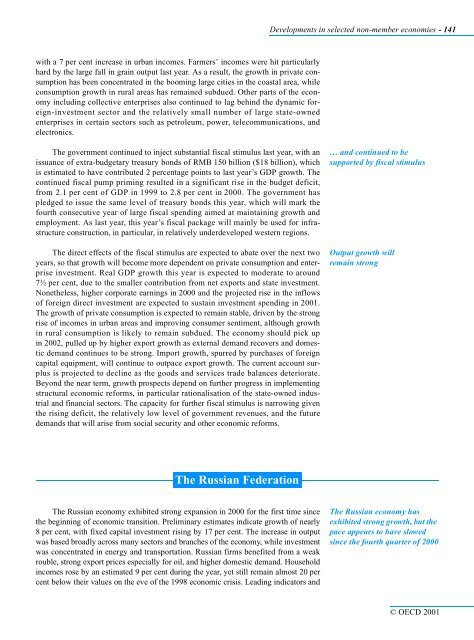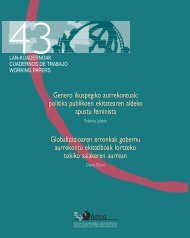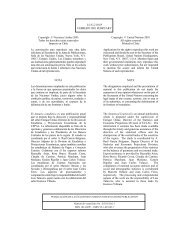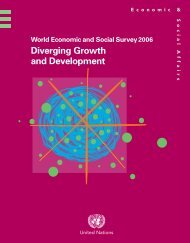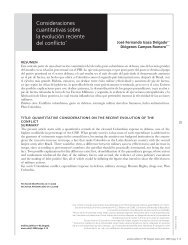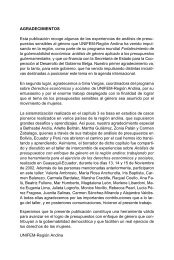OECD Economic Outlook 69 - Biblioteca Hegoa
OECD Economic Outlook 69 - Biblioteca Hegoa
OECD Economic Outlook 69 - Biblioteca Hegoa
You also want an ePaper? Increase the reach of your titles
YUMPU automatically turns print PDFs into web optimized ePapers that Google loves.
with a 7 per cent increase in urban incomes. Farmers’ incomes were hit particularly<br />
hard by the large fall in grain output last year. As a result, the growth in private consumption<br />
has been concentrated in the booming large cities in the coastal area, while<br />
consumption growth in rural areas has remained subdued. Other parts of the economy<br />
including collective enterprises also continued to lag behind the dynamic foreign-investment<br />
sector and the relatively small number of large state-owned<br />
enterprises in certain sectors such as petroleum, power, telecommunications, and<br />
electronics.<br />
The government continued to inject substantial fiscal stimulus last year, with an<br />
issuance of extra-budgetary treasury bonds of RMB 150 billion ($18 billion), which<br />
is estimated to have contributed 2 percentage points to last year’s GDP growth. The<br />
continued fiscal pump priming resulted in a significant rise in the budget deficit,<br />
from 2.1 per cent of GDP in 1999 to 2.8 per cent in 2000. The government has<br />
pledged to issue the same level of treasury bonds this year, which will mark the<br />
fourth consecutive year of large fiscal spending aimed at maintaining growth and<br />
employment. As last year, this year’s fiscal package will mainly be used for infrastructure<br />
construction, in particular, in relatively underdeveloped western regions.<br />
The direct effects of the fiscal stimulus are expected to abate over the next two<br />
years, so that growth will become more dependent on private consumption and enterprise<br />
investment. Real GDP growth this year is expected to moderate to around<br />
7½ per cent, due to the smaller contribution from net exports and state investment.<br />
Nonetheless, higher corporate earnings in 2000 and the projected rise in the inflows<br />
of foreign direct investment are expected to sustain investment spending in 2001.<br />
The growth of private consumption is expected to remain stable, driven by the strong<br />
rise of incomes in urban areas and improving consumer sentiment, although growth<br />
in rural consumption is likely to remain subdued. The economy should pick up<br />
in 2002, pulled up by higher export growth as external demand recovers and domestic<br />
demand continues to be strong. Import growth, spurred by purchases of foreign<br />
capital equipment, will continue to outpace export growth. The current account surplus<br />
is projected to decline as the goods and services trade balances deteriorate.<br />
Beyond the near term, growth prospects depend on further progress in implementing<br />
structural economic reforms, in particular rationalisation of the state-owned industrial<br />
and financial sectors. The capacity for further fiscal stimulus is narrowing given<br />
the rising deficit, the relatively low level of government revenues, and the future<br />
demands that will arise from social security and other economic reforms.<br />
The Russian Federation<br />
The Russian economy exhibited strong expansion in 2000 for the first time since<br />
the beginning of economic transition. Preliminary estimates indicate growth of nearly<br />
8 per cent, with fixed capital investment rising by 17 per cent. The increase in output<br />
was based broadly across many sectors and branches of the economy, while investment<br />
was concentrated in energy and transportation. Russian firms benefited from a weak<br />
rouble, strong export prices especially for oil, and higher domestic demand. Household<br />
incomes rose by an estimated 9 per cent during the year, yet still remain almost 20 per<br />
cent below their values on the eve of the 1998 economic crisis. Leading indicators and<br />
Developments in selected non-member economies - 141<br />
… and continued to be<br />
supported by fiscal stimulus<br />
Output growth will<br />
remain strong<br />
The Russian economy has<br />
exhibited strong growth, but the<br />
pace appears to have slowed<br />
since the fourth quarter of 2000<br />
© <strong>OECD</strong> 2001


